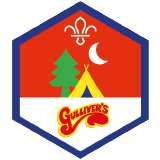Needy Ned
You’ll need
- Scrap paper
- Pens or pencils
- Stopwatch or phone
- Mascots
- Tokens
- Cameras (optional)
Before you begin
- This game is designed to introduce people to a campsite, so it’s best to do it soon after they arrive. It works well at a site with amenities such as a toilet block and drinking water taps, but it can be adapted for more basic campsites too – see ‘Change the level of challenge’ for tips.
- Create checklists of wants and needs for each group. We’ve put some ideas of what you might like to include below. Adapt the lists to encourage people to explore the whole of the site and all it has to offer.
- Make sure there are enough mascots for each group to have one – you could use anything from a cardboard cut out to an action figure.
- Decide how players will ‘check in’ at the different areas. It’s likely that there’ll be too many things to find to have a leader keeping track at each. You could ask each team to take a photograph of their mascot at each place, or leave stamps or tokens for people to collect.
- Decide whether you’ll set a time limit, to see who gets the most points in a fixed amount of time, or whether you’ll run the activity as a race, where the winner is the first team to get back to camp having met every need.
Introduce the game
- Everyone should chat about how they can use the space respectfully, without disturbing the wildlife or other people enjoying the site.
- The person leading the activity should set some boundaries. They should explain where the no-go zones are, where adults will be around the site, and what people should do if anyone in their team needs help.
- The person leading the activity should explain the signal to stop play. They should explain how long the game will go on for, and whether it’s a race to finish or a competition to get the most points in the time.
- Everyone should split into teams.
- Each team should get their mascot who represents their needy Ned.
- The person leading the activity should give everyone a list of Ned’s wants and needs. They should explain that each ‘need’ is worth five points and each ‘want’ is worth three points. They should also explain how the teams can show they’ve met the need, for example, whether they’ll collect tokens or take photos.
Play the game
- The person leading the activity should give a signal to begin the game.
- Everyone should explore the campsite with their needy Ned, finding the facilities to meet their needs. They’ll need to prioritise their needs over their wants, to get the maximum points.
- The person leading the activity should give a signal when the game ends. Everyone should return to the base camp.
- Everyone should count their scores, and the person leading the activity should announce the winner.
- If there are tokens around the site, everyone should walk back around with adults to collect everything so they leave no trace.
- If lots of people struggled to find a facility, it may be useful for the person leading the activity (or a team who did find it) to show them where it is.
- Ned needs the toilet
- Ned’s hungry
- Ned needs to collect firewood
- Ned needs to fill up their fire bucket
- Ned’s thirsty
- Ned’s feeling low and needs some advice about what to do
- Ned needs a shower
- Ned needs to recycle some cans
- Ned has a minor injury and they need some help
- Ned needs a shady pot to rest
- Ned’s feeling adventurous
- Ned wants to relax
- Ned wants to go bird spotting
- Ned wants a sweet, tasty snack
Reflection
This activity needed everyone to be responsible. It’s exciting to have a new space to explore, especially when it’s part of a competitive game, but it’s also important to respect wildlife and other people using the area. Did people notice any wildlife while they were playing? What about other people using the space? How can people be welcoming to wildlife and other people (while respecting the fact that they may want privacy and space)?
This activity was also about problem-solving. Was it obvious where people would need to go to meet each need? Did teams have a method, for example, did they meet the needs first before focussing on the wants, or plan a route? Did anyone get stuck on any of the wants or needs?
Safety
All activities must be safely managed. You must complete a thorough risk assessment and take appropriate steps to reduce risk. Use the safety checklist to help you plan and risk assess your activity. Always get approval for the activity, and have suitable supervision and an InTouch process.
- Outdoor activities
You must have permission to use the location. Always check the weather forecast, and inform parents and carers of any change in venue.
- Active games
The game area should be free of hazards. Explain the rules of the game clearly and have a clear way to communicate that the game must stop when needed. Take a look at our guidance on running active games safely.
- You could change Ned’s needs to match a more basic campsite. For example, for ‘Ned needs the toilet’, teams could identify a good place to dig a latrine. This might take a little longer, as teams will have to problem-solve, and it might be difficult to play with tokens if a few different areas are suitable.
- It’s up to you whether you distinguish the wants from the needs, or whether you leave it so identifying the wants is part of the challenge.
- You could award bonus points, for example, for creative photos, or if someone leading the activity spots a team working together well or being respectful of the campsite and others. Teams could even lose points if they leave someone behind!
- If a race isn’t suitable (for example, if some people aren’t able to go as fast), change the competitive element. Instead of awarding points for how many needs people meet (or how quickly they meet them), award points for creative photos or good teamwork. You don’t even have to make it a competition at all!
- Make sure all of the tokens and photo points are accessible for everyone. If some areas are likely to be inaccessible (for example, any buildings with steps or any steep areas).
All Scout activities should be inclusive and accessible.
If people are now familiar with the campsite, you could take it a step further by thinking about it critically. Could anything be improved if they had the power to magically move anything, including natural features? Make sure to think about the thoughts and feelings of the people who own and run the site as you chat. Campsite considerations may help people start their discussions.
Young people should take the lead in exploring their campsite so they can be more independent throughout the night away.


